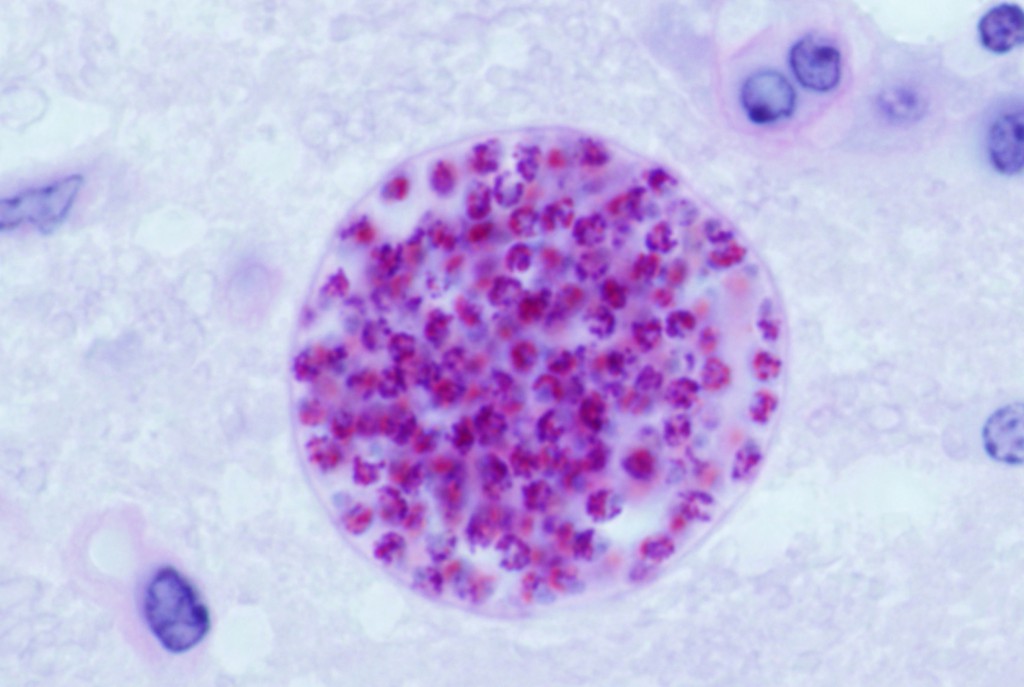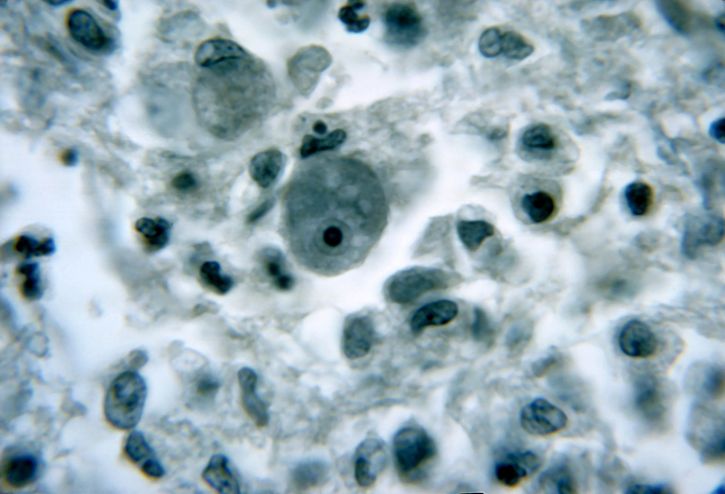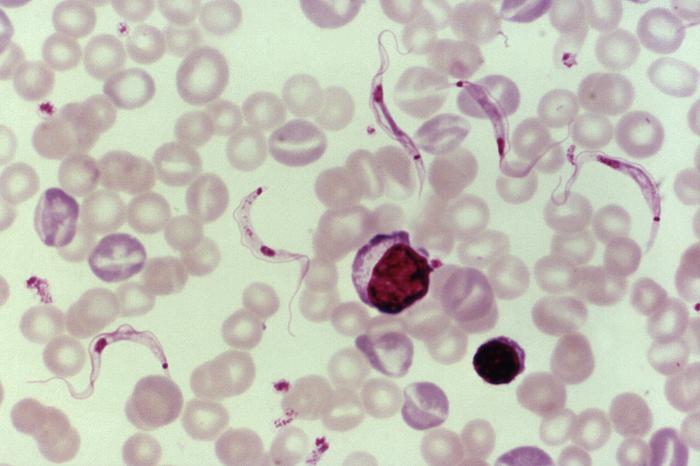Les parasites du cerveau.
par
popularité : 4%

Meet the Parasites That Control Human Brains
It’s time to enjoy some monster stories, and the scariest monsters of all are those that actually exist.
Join us as we share tales of some of the creepiest parasites around — those that control the brains of their human hosts, sometimes leaving insanity and death in their wake. These are the tales of neurological parasites.
The Feline Parasite
Toxoplasma gondii tops the list as the most famous — and most controversial — neurological parasite. This tiny protozoan doesn’t look like much more than a blob, but once it makes its way to the brain, it can radically alter the behavior of hosts like rats, cats and, yes, even humans.
T. gondii’s life begins in cat feces, where its eggs (known as “oocytes” or “egg cells”) wait to be picked up by carriers like rats. Once they’re safe and warm in the guts of their temporary hosts, the oocytes morph into tachyzoites, the unassuming little blobs that can really do some damage. Those tachyzoites migrate into their hosts’ muscles, eyes and brains, where they can remain hidden for decades without doing much of anything.

Microscopic cysts containing Toxoplasma gondii in mouse brain tissue (Credit : Jitender P. Dubey/USDA)
But when the moment comes to strike, the little T. gondii tachyzoites alter their hosts’ brain chemistry. Infected rats actually become sexually aroused by the smell of cats, and leap fearlessly into their claws, where they die and release the tachyzoites back into the cats, allowing the egg-laying cycle to start anew.
Creepy, perhaps, but not exactly the stuff of nightmares — except that rats aren’t the only hosts in which T. gondii hibernates. Some researchers estimate that as much as 30 percent of the people on earth — more than two billion of us — are carrying little T. gondii tachyzoites around in our brains right now.
What might this mean for human behavior ? Just as a start, some studies have found that cases of schizophrenia rose sharply around the turn of the twentieth century, when domestic cat ownership became common.
“We often see symptoms like altered activity levels, changes in risk behaviors, and decreased reaction times,” says Joanne Webster, a parasitology researcher at Imperial College, London. “But in some cases, they become more severe — like schizophrenia.”
Another paper, published in the journal Proceedings of the Royal Society B, argued that in areas with high T. gondii infection rates, these tiny parasites could cumulatively alter the behavioral patterns of entire cultures. Infected parents, researchers found, have a 30 percent chance of passing the parasite on to their children.
If that all seems a little far from home, though, consider this : Researchers estimate that more than 60 million people in the U.S. alone currently carry T. gondii, and most of those have no idea, because the parasite often causes no symptoms at all. Until the day it strikes, that is.
The Amoeba of Madness
If you’re hiking in the wilderness, stay away from warm, stagnant bodies of fresh water, no matter how thirsty you are. These inviting little ponds often play host to Naegleria fowleri, an amoeba species with a taste for human brain tissue.
N. fowleri can spend long spans of time just hanging around as a cyst, a little armored ball that can survive cold, heat, and dry conditions. When a cyst comes into contact with an inviting host, it sprouts tentacle-like pseudopods and turns into a form known as a trophozoite. Once it’s transformed, the trophozoite heads straight for the host’s central nervous system, following nerve fibers inward in search of the brain.

Damage (black cavities) caused by Naegleria fowleri as seen in a brain tissue sample. (Credit : Dr. Martin D. Hicklin, USCDCP)
Once it’s burrowed into its host’s brain tissue — usually the olfactory bulbs — N. fowleri sprouts a “sucking apparatus” called an amoebostome and starts chowing down on juicy brain matter. As the amoeba divides, multiplies and moves inward, devouring brain cells as it goes, its hosts can go from uncomfortable to incoherent to unconscious in a matter of hours.
The symptoms start subtly, with alterations in tastes and smells, and maybe some fever and stiffness. But over the next few days, as N. fowleri burrows deeper into the brain’s cognitive structures, victims start feeling confused, have trouble paying attention, and begin to hallucinate. Next come seizures and unconsciousness, as the brain loses all control. Two weeks later, the victim’s most likely perishes — although one man in Taiwan managed to stick it out for a grueling 25 days before his nervous system finally gave out.
Although N. fowleri infections are rare in the extreme — worldwide historical totals number only in the hundreds — they’re almost always fatal, and tricky to catch and treat before they spiral out of control. Even so, you’d be wise to avoid warm pools of still water, lest you end up with an uninvited guest on the brain.
The Virus That Brings Fear
We’ve all been warned to stay clear of wild cats and dogs, and never to bother animals we find wandering the streets of a city. Friendly as they might look, they could easily be carrying the deadly rabies virus, which doesn’t always cause the telltale mouth-foaming — though it does alter its victims’ brain functions in profound ways.
This bullet-shaped virus — so small and sneaky that it often escapes detection by the immune system — doesn’t need much of an invitation to dive into a new host ; a simple puncture wound will do it. Once it’s inside the host’s bloodstream, it quickly starts taking over cells, transforming them into rabies factories that churn out thousands of copies of the virus. As the attackers grow in number, they make their way to the host’s central nervous system, and head for the brain.
But rabies viruses don’t just settle down anywhere in the brain, they specifically seek out the hippocampus, amygdala and hypothalamus, brain structures that play central roles in memory, fear and emotion. And they don’t just devour brain cells indiscriminately, either ; instead, they alter the ways these cells release neurotransmitters like serotonin, GABA, and endogenous opioids. In other words, they turn their hosts’ own brain chemistry against them.

A dog suspected of being rabid that had been exhibiting signs of restlessness, and overall uncharacteristic aggressive behavior. (Credit : CDC)
In the altered states brought on by a rabies infection, animals often lash out at any nearby living thing, but this may be more out of fear than anger. Human rabies patients become terrified of water and puffs of air, both of which make them flinch and twitch uncontrollably.
If the infection goes untreated, rabies patients fall deeper into confusion and hallucination, lashing out at imagined threats and hapless bystanders. They lose their ability to sleep, sweat profusely, and finally fall into a paralyzed stupor as their brain function slips into chaos. A few days later, as the paralysis reaches their hearts and lungs, they fall into a coma and die.
Once rabies has infected a human, survival is all-but impossible. To date, fewer than 10 people have survived a clinical-stage rabies infection — ever, in history. Many doctors consider the disease untreatable. The better news, though, is that it’s easily preventable with a vaccine. If you plan on traveling anywhere wild animals roam, you’d do well to go protected.
The Parasite of Sleep
In the villages of sub-Saharan Africa and the wilds of the Amazon, the tiniest insect can bring a sleep that leads to death. The tsetse fly loves the taste of human blood, and it often carries a parasite known as Trypanosoma, whose tastes run more toward human brains.
Parasites of the genus Trypanosoma start their lives in the guts of invertebrate hosts, but quickly develop through a series of increasingly complex forms when they come into contact with the mammalian fluids they crave. In the first stage of infection, known as the haemolymphatic stage, the parasites live in the host’s blood and lymph nodes, where they grow from nondescript little ovals into long squirmy splotches equipped with whip-like flagellae.

Trypanosoma lewisi flagellate parasites (red, hooked cells) in a blood sample (maginfied 1000x). (Credit : CDC/ Dr. Mae Melvin)
As they mature, the parasites cross the blood-brain barrier and the encephalitic stage begins. The Trypanosoma alter the structure and function of their hosts’ brain cells (the parasites seem have a particular penchant for the hypothalamus, which helps regulate our mood and sleep/wake cycles) and the hosts start to feel and behave strangely. First they suffer headaches and have trouble sleeping, or sleep and wake at odd hours, due to the parasite’s alteration of the rhythm in which the sleep hormone melatonin gets released.
Before long, though, human hosts start to exhibit a dizzying variety of other psychological symptoms, from changing appetites to depression to odd speech patterns to uncontrollable itching and tremors. Over the next few years, the host’s odd behavior gradually starts to lapse into laziness, unresponsiveness, and finally a prolonged sleep that leads to coma and death, hence the name “sleeping sickness.”
Although a cure for trypanosomiasis exists, victims’ friends and families often fail to catch the disease early enough, and for a very simple reason : The sheer range and unpredictability of the infection’s symptoms makes it extremely hard to recognize. If you had a friend who suddenly started waking at odd hours and eating less, would your first thought be, “He probably has a protozoan invading his brain ?” No, you’d think, “He’s probably depressed,” which is exactly what the friends and families of most Trypanosoma hosts think — until it’s too late.
Scientific fact, as so often happens, is stranger than fiction when it comes to these parasites. From worms that devour brain cells to viruses that bring on crippling paranoia, these creatures are every bit as ghoulish as those in any fireside ghost story.
“The brain is a ‘privileged site’ for many parasites,” Webster says. “And that really challenges the concept of free will — after all, is it us or our parasites who ‘decide’ our behavior ?”
With that in mind — no pun intended — have a frightfully wonderful Halloween night, and don’t let the neurological parasites bite !
